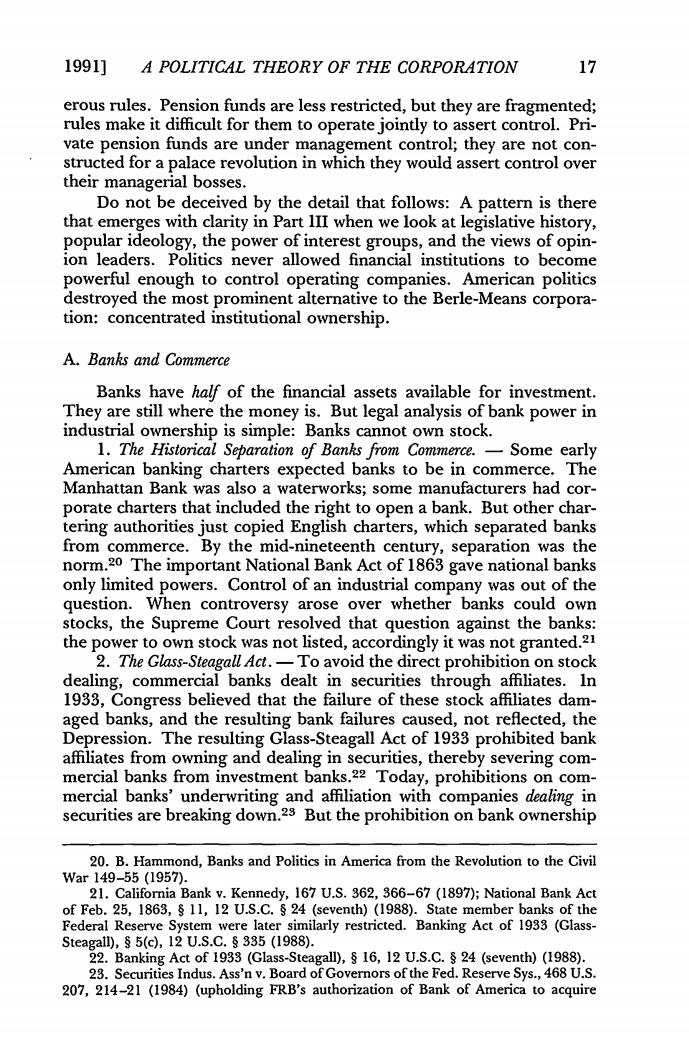正在加载图片...

1991] A POLITICAL THEORY OF THE CORPORATION 17 erous rules.Pension funds are less restricted,but they are fragmented; rules make it difficult for them to operate jointly to assert control.Pri- vate pension funds are under management control:they are not con- structed for a palace revolution in which they would assert control ov their manager al bosses Do not be deceived by the detail that follows:A pattern is there 三 that emerges with clarity in Part III when we look at legislative history, ough to cont rol op erating compan destroyed the most prominent alternative to the Berle-Means corpora- tion:concentrated institutional ownership. A.Banks and Commerce Banks have half of the financial assets available for investment e the mo ial ownership is simple: s cannot own stoc 1.The Historical Separation of Banks from Commerce. Some early American banking charters expected banks to be in commerce.The Manhattan Bank was also a waterworks;some manufacturers had cor- achaters that included the right to open a bank.But other cha opied English ch which sepa rated banks By the mid-nin omThe important National Bank Act of 1863 gave national banks eteenth century,separation was the only limited powers.Control of an industrial company was out of the question.When controversy arose over whether banks could own stocks,the Supreme Court resolved that question against the banks: the pow t wn stock s no t listed, ngly it wa 2.The Glass-Ste granted.21 gall Act.- To avoid the direct prohibition on stock dealing,commercial banks dealt in securities through affiliates. In 1933,Congress believed that the failure of these stock affiliates dam- aged banks.and the resulting bank failures caused.not refected.the Dep ession The ng Glass-Ste eagall Act of 1933 pr ohibited bank tes f owning and dealing in curties,there everng com mercial banks from investment banks. Today,prohibitions on com- mercial banks'underwriting and affiliation with companies dealing in securities are breaking down.2s But the prohibition on bank ownership 20.B.Hammond.Banks and Politics in America from the Revolution to the Civil war149-55(1957). k v.Ker nedy,167 U.S.362,366-67(1897);National Bank Ac of Fet th s5⊙,12U.s.C.s3351988). Banking Banking Act of (Glass-Stcagal)6,12U..C.4(scventh)() 23.Securities Indus.Ass'n v.Board of Governors of the Fed.Reserve Sys.,468 U.S 207,214-21 (1984)(upholding FRB's authorization of Bank of America to acquire 1991] A POLITICAL THEORY OF THE CORPORATION 17 erous rules. Pension funds are less restricted, but they are fragmented; rules make it difficult for them to operate jointly to assert control. Private pension funds are under management control; they are not constructed for a palace revolution in which they would assert control over their managerial bosses. Do not be deceived by the detail that follows: A pattern is there that emerges with clarity in Part III when we look at legislative history, popular ideology, the power of interest groups, and the views of opinion leaders. Politics never allowed financial institutions to become powerful enough to control operating companies. American politics destroyed the most prominent alternative to the Berle-Means corporation: concentrated institutional ownership. A. Banks and Commerce Banks have half of the financial assets available for investment. They are still where the money is. But legal analysis of bank power in industrial ownership is simple: Banks cannot own stock. 1. The Historical Separation of Banks from Commerce. - Some early American banking charters expected banks to be in commerce. The Manhattan Bank was also a waterworks; some manufacturers had corporate charters that included the right to open a bank. But other chartering authorities just copied English charters, which separated banks from commerce. By the mid-nineteenth century, separation was the norm. 20 The important National Bank Act of 1863 gave national banks only limited powers. Control of an industrial company was out of the question. When controversy arose over whether banks could own stocks, the Supreme Court resolved that question against the banks: the power to own stock was not listed, accordingly it was not granted. 2 1 2. The Glass-SteagallAct. - To avoid the direct prohibition on stock dealing, commercial banks dealt in securities through affiliates. In 1933, Congress believed that the failure of these stock affiliates damaged banks, and the resulting bank failures caused, not reflected, the Depression. The resulting Glass-Steagall Act of 1933 prohibited bank affiliates from owning and dealing in securities, thereby severing commercial banks from investment banks. 22 Today, prohibitions on commercial banks' underwriting and affiliation with companies dealing in securities are breaking down.23 But the prohibition on bank ownership 20. B. Hammond, Banks and Politics in America from the Revolution to the Civil War 149-55 (1957). 21. California Bank v. Kennedy, 167 U.S. 362, 366-67 (1897); National Bank Act of Feb. 25, 1863, § 11, 12 U.S.C. § 24 (seventh) (1988). State member banks of the Federal Reserve System were later similarly restricted. Banking Act of 1933 (GlassSteagall), § 5(c), 12 U.S.C. § 335 (1988). 22. Banking Act of 1933 (Glass-Steagall), § 16, 12 U.S.C. § 24 (seventh) (1988). 23. Securities Indus. Ass'n v. Board of Governors of the Fed. Reserve Sys., 468 U.S. 207, 214-21 (1984) (upholding FRB's authorization of Bank of America to acquire